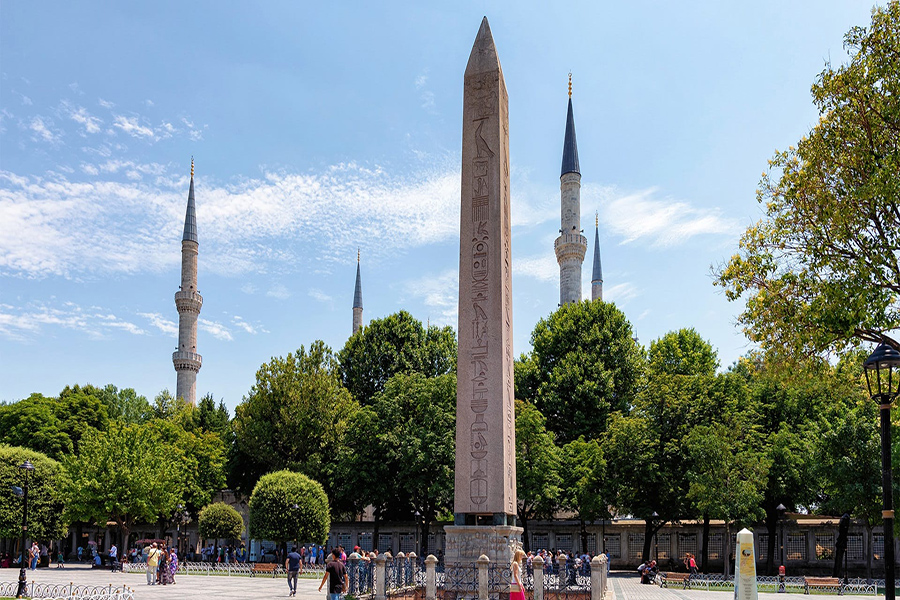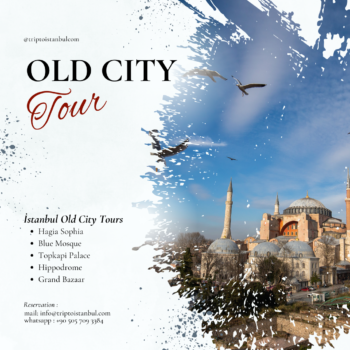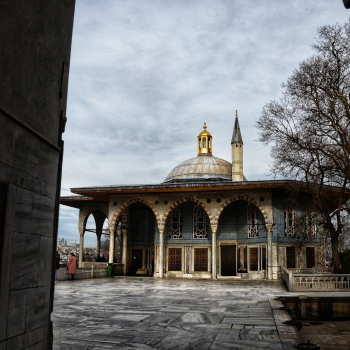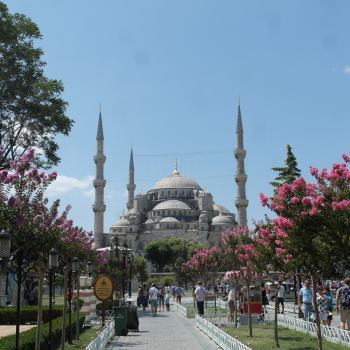Sultanahmet Square (Turkish: Sultanahmet Meydanı) or the Hippodrome of Constantinople (Greek: Ἱππόδρομος τῆς Κωνσταντινουπόλεως, romanized: Hippódromos tēs Kōnstantinoupóleōs; Latin: Circus Maximus Constantinopolitanus; Turkish: Hipodrom) is a square in Istanbul, Turkey. Previously, it was a circus that was the sporting and social centre of Constantinople, capital of the Byzantine Empire.
The word hippodrome comes from the Greek hippos (ἵππος), horse, and dromos (δρόμος), path or way. For this reason, it is sometimes also called Atmeydanı (“Horse Square”) in Turkish. Horse racing and chariot racing were popular pastimes in the ancient world and hippodromes were common features of Greek cities in the Hellenistic, Roman and Byzantine eras.
History
Although the Hippodrome is usually associated with Constantinople’s days of glory as an imperial capital, it actually predates that era. The first Hippodrome was built when the city was called Byzantium, and was a provincial town of moderate importance. In AD 203 the Emperor Septimius Severus rebuilt the city and expanded its walls, endowing it with a hippodrome, an arena for chariot races and other entertainment.
In AD 324, the Emperor Constantine the Great decided to refound Byzantium after his victory at the nearby Battle of Chrysopolis; he renamed it Nova Roma (New Rome). This name failed to impress and the city soon became known as Constantinople, the City of Constantine. Constantine greatly enlarged the city, and one of his major undertakings was the renovation of the Hippodrome. It is estimated that the Hippodrome of Constantine was about 450 m (1,476 ft) long and 130 m (427 ft) wide. The carceres (starting gates) stood at the northern end; and the sphendone (curved tribune of the U-shaped structure, the lower part of which still survives) stood at the southern end.[1] The spina (the middle barrier of the racecourse) was adorned with various monuments, including the monolithic obelisk, the erection of which is depicted in relief carvings on its base.
The stands were capable of holding 100,000 spectators. The race-track at the Hippodrome was U-shaped, and the Kathisma (emperor’s lodge) was located at the eastern end of the track. The Kathisma could be accessed directly from the Great Palace through a passage which only the emperor or other members of the imperial family could use.
Hippodrome monuments
Serpent Column
Main article: Serpent Column
The Serpent Column
To raise the image of his new capital, Constantine and his successors, especially Theodosius the Great, brought works of art from all over the empire to adorn it. The monuments were set up in the middle of the Hippodrome, the spina. Among these was the sacrificial tripod of Plataea, now known as the Serpent Column, cast to celebrate the victory of the Greeks over the Persians during the Persian Wars in the 5th century BC. Constantine ordered the Tripod to be moved from the Temple of Apollo at Delphi, and set in middle of the Hippodrome. The top was adorned with a golden bowl supported by three serpent heads, although it appears that this was never brought to Constantinople. The serpent heads and top third of the column were destroyed in 1700. Parts of the heads were recovered and are displayed at the Istanbul Archaeology Museum. All that remains of the Delphi Tripod today is the base, known as the “Serpentine Column”.
Obelisk of Thutmose III
Main article: Obelisk of Theodosius
Obelisk of Theodosius in Hippodrome
Another emperor to adorn the Hippodrome was Theodosius the Great, who in 390 brought an obelisk from Egypt and erected it inside the racing track. Carved from pink granite, it was originally erected at the Temple of Karnak in Luxor during the reign of Thutmose III in about 1490 BC. Theodosius had the obelisk cut into three pieces and brought to Constantinople. The top section survives, and it stands today where Theodosius placed it, on a marble pedestal. The granite obelisk has survived nearly 3,500 years in good condition.
Walled Obelisk
Main article: Walled Obelisk
The Walled Obelisk
In the 10th century the Emperor Constantine Porphyrogenitus built another obelisk at the other end of the Hippodrome. It was originally covered with gilded bronze plaques, but they were sacked by Latin troops in the Fourth Crusade. The stone core of this monument also survives, known as the Walled Obelisk.
Statues of Porphyrius
Seven statues were erected on the Spina of the Hippodrome in honour of Porphyrius the Charioteer, a legendary charioteer of the early 6th century who in his time raced for the two parties which were called “Greens” and “Blues”. None of these statues have survived. The bases of two of them have survived and are displayed in the Istanbul Archaeological Museum.
Below are our group and private tours or art activities that may interest you.




